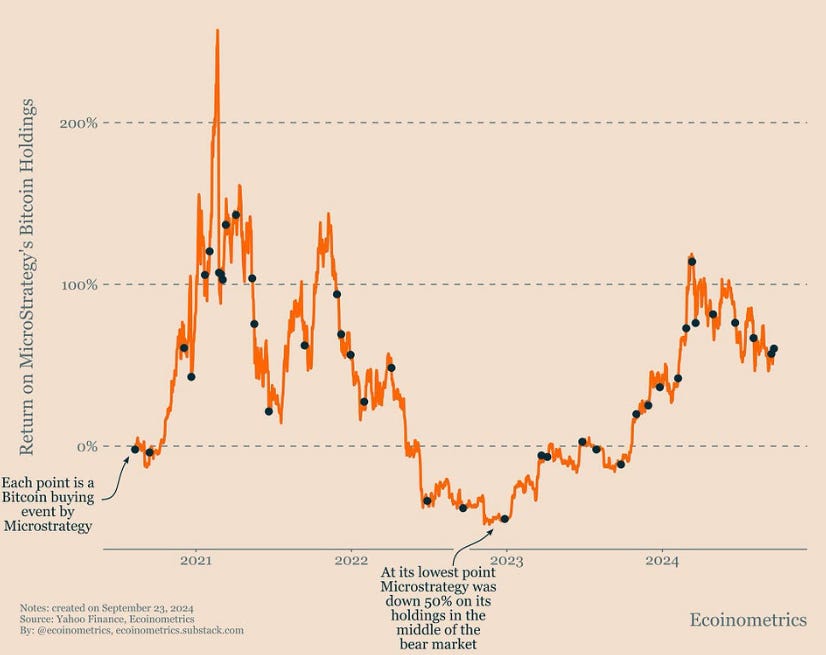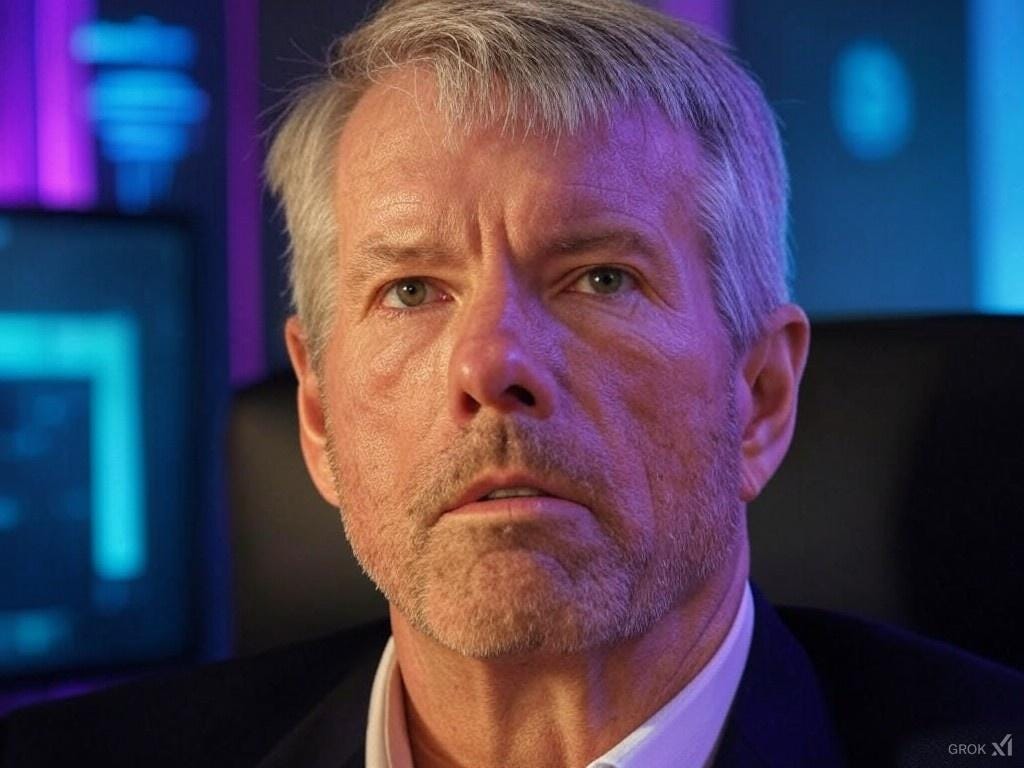Michael Saylor's Recent Explanation About Bitcoin Is the Most Important in History.
It puts into context how significant the opportunity is.
Over the holiday season, Carrot Lane gathered another 1,000 subscribers, and what it speaks to is the growing momentum in Crypto.
So I thought I would re-share this viral hit for our newest members to tuck into and as a light refresher for folks who read this some months ago.
Michael Saylor’s way with words really draws you in, and he always seems to touch on that subtle gap between reality and perception.
If you enjoy reading and want to explore my work in more depth, please support me by upgrading to a paid membership (and if you're already a member, I bloody love you!).
Annual subscribers get a complimentary 1-2-1 strategy call and a 37% discount for the entire year for joining. Founding members get the same but also access to a private daily group and first access to projects.
If the cost is a barrier, please feel free to drop me a message—I’m here to help!
Michael Saylor is a quirky businessman with an extraordinary gift for breathing life into the most complicated subjects through his storytelling.
He bleeds Bitcoin.
For ages, I’ve been fascinated by his knack for dismantling every objection sceptics raise against the world's leading cryptocurrency.
My favourite interview was when the interviewer told Saylor, “You embody someone with remarkable conviction and a strong risk appetite.”
True to his style, Saylor never answered with, “It’s not risky,” but instead used an analogy I had never heard before.
Michael Saylor — Source
“How many chairs are you sitting on right now? Are you all in on the chair? The point is really that you put on one pair of glasses, you’ve got one pair of AirPods, you’re looking at me through one screen, and you’re using one microphone. Do you trust it? Is that conviction? It seems kinda scary. Why don’t you diversify? Why don’t you use ten microphones?”
It’s beyond thought-provoking.
It’s clear to regular readers of Carrot Lane that I’m not a Bitcoin maxi. I want to maximise my capital allocation to some newer blockchains that are less liquid and have the potential to increase by a higher percentage.
This is not to say that I won’t be rotating some of my 70/30 allocations in Solana and SUI, respectively, back into BTC as my safe haven asset.
Comparative data indicates that the Gold ETF, which BlackRock CEO Larry Fink has compared to Bitcoin as digital gold, only saw a drop or correction six years after its launch.
We often hear about Bitcoin’s fixed 21 million supply and deflationary effects, driven by lost BTC and halving events. In contrast, with gold, the traditional response to rising prices has always been for miners to dig up more.
Here’s the data before and after the gold ETF.
Total Gold Mined (1989–2003): 34,664 metric tons
Total Gold Mined (2004–2018): 40,950 metric tons
Micro Strategy is outperforming the magnificent 7.
Saylor is relentless.
His company, MicroStrategy, originally a technology company, currently holds 252,220 bitcoins, averaging $39,292.18 USD each, totalling $9.91 billion.
With Bitcoin at $61,500, their holdings are worth around $15.51 billion, giving them over $5.6 billion in profit if they sold today.
Saylor appears unconcerned about his cost basis and has an incredibly long-term perspective. He argues that even if you bought New York property 200 years too late, you would still have made a profit.
Michael Saylor — Source
“Investing in Bitcoin is like buying into New York City 250 years ago — sure, you’re late, but someone was there 14 years before you. I once tweeted that Bitcoin would go the way of online gambling when it was just $100. I was wrong—I ended up buying it at $9,500 to $10,000 instead. People will buy it at $100,000, a million, or even 10 million. Just look at Manhattan — people pay $10 million for 4,000 square feet. All of Manhattan was once bought for around $29 in beads. Don’t focus on the unit price—ask yourself: What is the dominant network in cyberspace? Bitcoin is that network.”
For all the traditional finance Bitcoin deniers and those quick to label it a Ponzi scheme, MicroStrategy’s stock performance has obliterated the entire market.
It’s up 1,325% since MicroStrategy first bought the coin in 2020. It’s also up over 51% annually compared to the so-called magnificent 7, up only 27%.
Saylor is going to buy the ‘Bitcoin top’ forever.
MicroStrategy began dollar-cost averaging into Bitcoin four years ago and has invested in the asset 40 times.
Unrealised returns have always been positive, except for one moment during the bear market when their holdings were down by 50%.
Michael Saylor vowed not to sell his holdings until he discovered a gaping loophole in the U.S. tax code. MicroStrategy sold 704 bitcoins before repurchasing 810 BTC two days later.
According to an SEC filing — MicroStrategy sold 704 bitcoins in 2022 for roughly $11.8 million at $16,700 per bitcoin after fees.
Two days later, they bought back 810 BTC at around $16,800 each and stated in the SEC filing that they were exploiting the wash trading rules.
Note: A wash sale happens when you sell a security at a loss and then buy the same security (or something very similar) within 30 days before or after that sale. This creates a 61-day window — if you repurchase within this timeframe, the wash sale rule kicks in, and the loss or tax deduction is disallowed.
But not when it came to flipping Bitcoin—so Saylor made the most of it.
The filing read:
“MicroStrategy plans to carry back the capital losses resulting from this transaction against previous capital gains, to the extent such carrybacks are available under the federal income tax laws currently in effect, which may generate a tax benefit.”

Don’t budge, and avoid falling into this all-too-common trap.
My most significant aha moment in crypto was removing my association with volatility and risk.
Volatility is the element of crypto that gives you the upside potential, but for many, including me, it can play with your emotions.
Fixating on price, trying to time the top, or trading in and out of assets is not an effective strategy.
Bitcoin and investing expert Larry Lepard summed it up perfectly in a recent interview:
“Historically, I think the (Bitcoin) volatility is becoming less over time. There’s some evidence of that, but having said that, everyone needs to be prepared to deal with the volatility, and everybody needs to think long-term.
In the long term, I’m quite confident that this is going to be a multi-million dollar per coin asset. So if you’re buying it at $72,000 today, and it feels like you’re paying too much, just know when Max Kaiser was buying his first coins, he paid 50 cents, and he felt like he’d overpaid because Trace Mayer, who’s a true OG, was buying his at 30 cents.
So, pretty much everybody who’s in Bitcoin feels like they’re too late, and they’re overpaying until about five or ten years go by. Then, you’re thinking, ‘Hang on, you have one whole coin? You bought Bitcoin for under $100K? Wow, yeah, exactly.’”
Avoid these investing traps.
I heard this summed up perfectly in a podcast recently:
There are three different personas for people who buy Bitcoin.
Persona One: The Newcomer
You’re new to Bitcoin.
You see the current price and think you might have overpaid, feeling like you’ve entered the market too late.
Persona Two: The Trader
You actively trade Bitcoin.
When the price surges by 20%, 30%, 40%, or even 50%, you sell, believing the price increase is unsustainable, and switch to what you perceive as a better investment at that moment.
Persona Three: The Veteran Hodler
You’ve experienced at least one if not multiple, Bitcoin market cycles.
While new all-time highs are less thrilling, you’re more frustrated because you wish you had bought more Bitcoin when it was cheaper, reflecting on missed opportunities during dips.
The alternative is to treat Bitcoin like New York real estate 200 years ago or the ETFs that don’t care about market fluctuations in this emerging industry.
They’ve already scooped up a staggering $74 billion in BTC, with daily inflows hitting record highs of over $1 billion.
So scan out a little, add a sprinkle of patience and show faith in the laws of supply and demand.
Final Thoughts.
Michael Saylor's message is to have a long-term time horizon and make a solid, concentrated bet on the dominant Network.
Diversification doesn’t help.
If anything — it’s a distraction from the top-performing assets.
Having said all that, my Bitcoin position is tiny compared to what I hold in Solana and SUI — because I’m one of the small guys, and these assets are rising optically together.
I want to optimise my asset allocation to the best I can.
This is summed up perfectly by a comment from Raoul Pal on X:
“I love BTC and 1,000% believe in it and it’s future, but my job is optimal capital allocation at this point in my life and that means aggressive risk-taking which is what I do for a living.”
Michael Saylor’s message about staying locked into Bitcoin is hands down the most crucial message for most people who aren’t ready to embrace significant risks.
It’s probably the most important explanation in history.






The volatility of Bitcoin has reduced significantly. With so many big players who buy and never sell (= stabilize the price), there's no more reason for it to swing by 30-40% a day. Shame if you ask me. But what can we do? Just DCA into it.
Man, that chair/microphone analogy is an elite take on how conviction drives long-term holds. Thanks for resurfacing that.
Also, someone needs to put "it's going up forever, Laura" on a tee. Maybe I'll get it done. LMK if you'd want one.